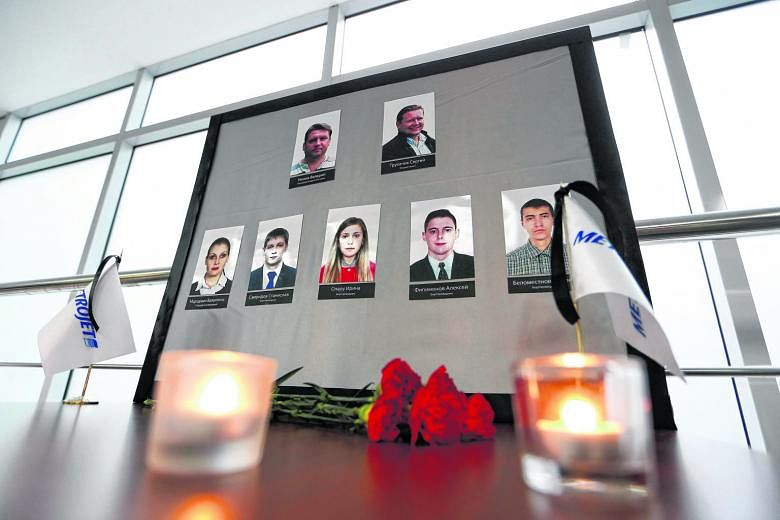CAIRO • The Russian plane that crashed in Egypt was not struck from the outside and the pilot did not make a distress call before it disappeared from radar, a source in the committee analysing the flight recorders said yesterday .
The source declined to give more details, but based his comments on the preliminary examination of the black boxes recovered from the Airbus A321 which crashed in the Sinai Peninsula last Saturday, killing all 224 people on board. A civil aviation source said only that Egyptian investigators, aided by Russian and French experts, had not yet finished examining the black boxes.
But earlier in the day, the airline operator, Kogalymavia, had said that an external impact probably caused structural damage leading to the crash.
"It could have been anything," Mr Alexander Smirnov, deputy general director for Kogalymavia, known by the Metrojet brand, told reporters at a briefing in Moscow yesterday, declining to comment on a possible terrorist attack. "The only reasonable explanation may be a mechanical impact on the aircraft."

The plane probably broke up in midair after reaching a cruising altitude of 9,448m, scattering debris over a wide area. Before falling, it slowed abruptly and the crew did not make any attempts at emergency radio contact, Mr Smirnov said.
"The crew totally lost control and, for that reason, there was not one attempt to get in contact... The plane was in excellent condition," Mr Smirnov said. "We rule out a technical fault and any mistake by the crew," he added.
When aircraft wreckage, like the battered remains of the Russian passenger jet, is spread over a wide area on the ground, there is little doubt that the plane broke up in the sky. What is far more difficult to explain is how an airliner built to withstand the most extreme turbulence possible and equipped with computerised flight limits to ensure it never loses control could have been ripped to pieces.
One area which investigators will pay close attention to is damage to the Metrojet A-321 when its tail struck the runway while landing in Cairo in 2001. The plane was repaired and returned to service, according to Ascend Worldwide, a London-based company which gathers data for insurers.
There have been at least two similar accidents caused by improper repairs after tail damage.
China Airlines Flight 611, a Boeing 747 flying from Taiwan to Hong Kong on May 25, 2002, broke apart when a repair failed, causing an explosive decompression, according to Taiwan's Aviation Safety Council. All 225 people aboard died when it fell into the Taiwan Strait. The jet's tail had been repaired 22 years earlier.
In the other incident, Japan Airlines Flight 123 crashed into a mountain in Japan on Aug 12, 1985, after a repair to its tail came apart, destroying key flight control surfaces. Seven years earlier, its tail had been repaired after it struck the ground during touchdown, according to Japan's Aircraft Accident Investigation Commission. The crash killed 520 out of 524 people on board.
In both cases, part of the aircraft structure that holds in air at high altitudes, known as the aft pressure bulkhead, was damaged when the planes' tails scraped the runway.
Some photos of the wreckage in Egypt appear to show that the plane's tail section fell separately from the rest of the plane.
If the A-321 being operated by Metrojet lost its aft pressure bulkhead, "it would cause very, very serious controllability problems", Mr John Cox, a former United States airline pilot who has participated in accident investigations, said in an interview.
Another cause of midair break-ups has been explosions in aircraft fuel tanks, according to Mr Steve Wallace, who is former chief of the US Federal Aviation Administration's accident investigation division. TWA Flight 800, another 747, crashed into the Atlantic Ocean near New York on July 17, 1996, as a result of such an explosion, killing all 230 aboard, according to the NTSB.
The black boxes will provide important clues about what happened, said Mr Paul Hayes, director of safety at Ascend Worldwide.
"They've got the wreckage, they've got the recorders, they've got the air traffic control recordings, so hopefully they should start being able to put together some kind of sequences of events or circumstances leading to the impact," Mr Hayes said.
Russian President Vladimir Putin called on investigators yesterday to build an "objective picture" of what happened.
"Without any doubt everything should be done so that an objective picture of what happened is created, so that we know what happened," Mr Putin said in comments cited by ITAR-TASS.
BLOOMBERG, AGENCE FRANCE-PRESSE, REUTERS

